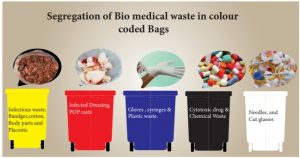Bio Medical Wastes:

The National Green Tribunal (NGT) has recently directed various authorities to ensure compliance from the biomedical waste management facilities in the country.
- Central Level: The Central Pollution Control Board (CPCB) to ensure strict compliance of biomedical waste management rules and scientific disposal of the waste.
- State Level: The Chief Secretaries of all the States/UTs to oversee compliance and ensure that authorisation is secured by every health care facility in their respective jurisdiction and also there is adherence to the norms.
- District Level: The District Magistrates in accordance with the District Environmental Plans.
Groundwater Contamination: While permitting deep burials, it may be ensured that groundwater contamination does not take place. - Segregation: Ensure that hazardous bio-medical waste is not mixed with the general waste.
- Frequent Violation of Rules: The direction came as a result of regular fines being imposed on various healthcare facilities and biomedical waste treatment facilities
- Earlier Observation: The segregation of Covid-19 biomedical waste from general garbage is a must to avoid further contamination adversely affecting public health.
Bio-Medical Waste Management Rules, 2016
- Biomedical waste is defined as human and animal anatomical waste, treatment apparatus like needles, syringes and other materials used in health care facilities in the process of treatment and research.
- Objective: The objective of the rules is to properly manage the per day bio-medical waste from Healthcare Facilities (HCFs) across the country.
- Ambit: The ambit of the rules has been expanded to include vaccination camps, blood donation camps, surgical camps or any other healthcare activity.
- Phase Out: Chlorinated plastic bags, gloves and blood bags has been phased out within two years starting from March 2016.
- Pre-treatment: Pre-treatment of the laboratory waste, microbiological waste, blood samples and blood bags through disinfection or sterilization on-site in the manner prescribed by the World Health Organization (WHO) or by the National AIDS Control Organisation (NACO).
- Bio-medical waste has been classified into 4 categories instead of the earlier 10 categories to improve the segregation of waste at source.
- Stringent Standards for Pollutants: The rules prescribe more stringent standards for incinerators to reduce the emission of pollutants in the environment.
- The State Government provides the land for setting up common bio-medical waste treatment and disposal facility




